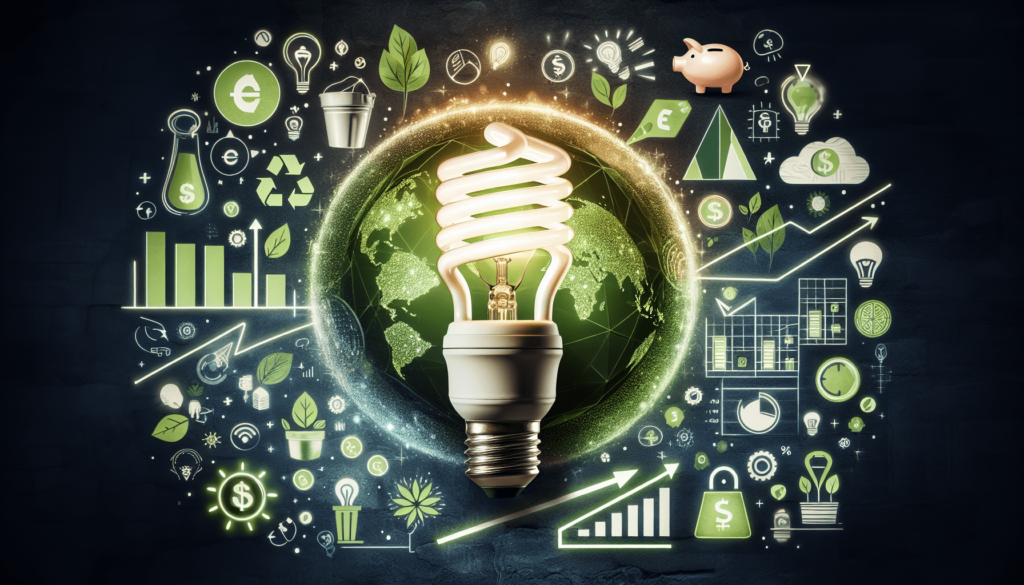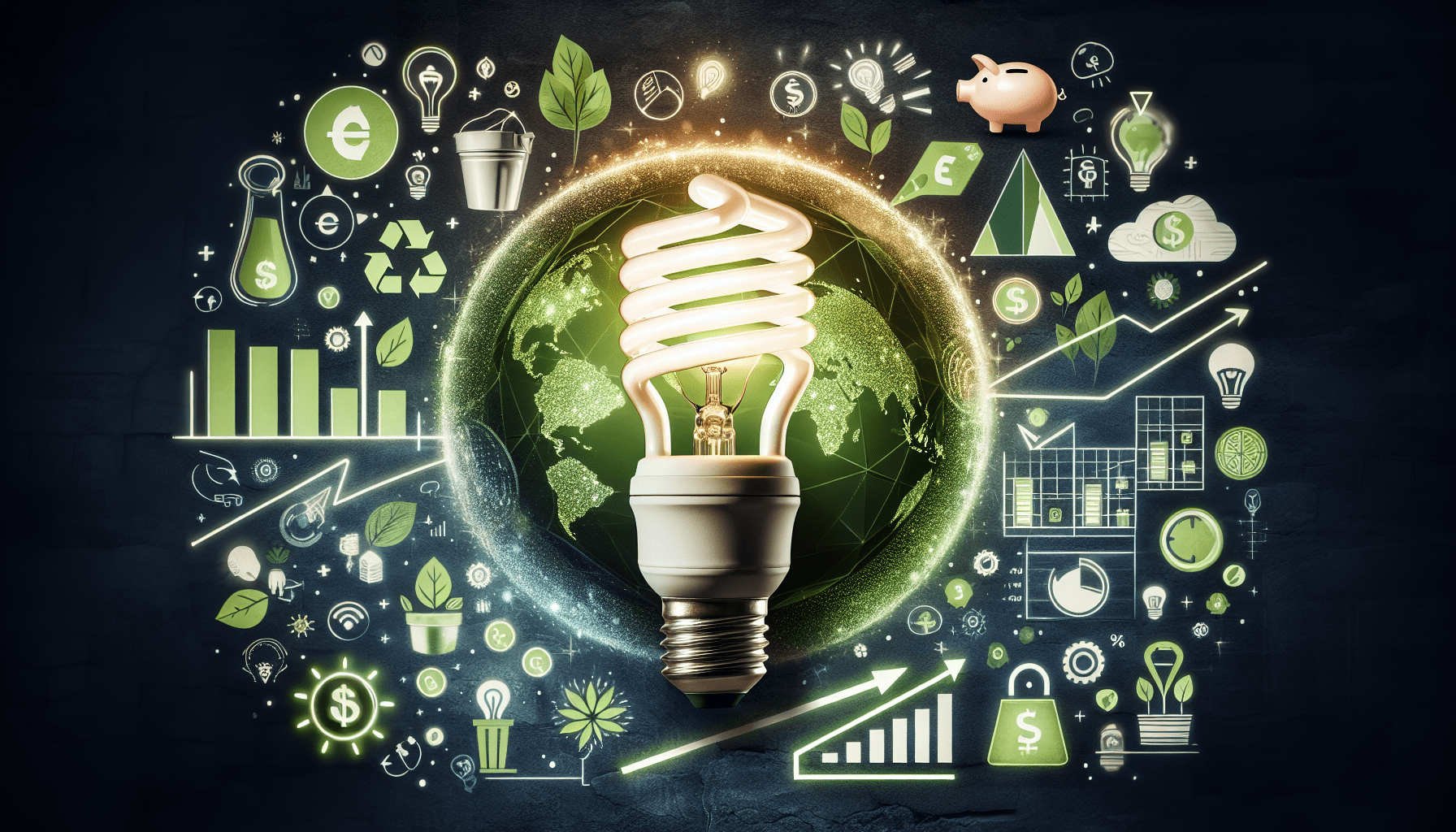Imagine stepping into a room where the soft glow of energy-efficient lighting bathes the space, creating a warm and inviting atmosphere. Not only does this lighting option reduce your energy consumption, but it also offers a myriad of benefits that go beyond just saving money on your electricity bill. From improving productivity and enhancing mood to promoting environmental sustainability, energy-efficient lighting is a game-changer that can transform the way you experience your surroundings. Discover the wide-ranging advantages of energy-efficient lighting and how it can positively impact your life in more ways than one.

Energy Savings
Lower Energy Consumption
One of the primary benefits of energy-efficient lighting is the reduction in energy consumption. By using energy-efficient bulbs, you can significantly lower your electricity usage compared to traditional incandescent bulbs. Energy-efficient bulbs, such as LED (light-emitting diode) and CFL (compact fluorescent lamp) bulbs, are designed to consume less electricity while still providing the same amount of light. This means that by simply replacing your old incandescent bulbs with energy-efficient ones, you can immediately start saving on your energy bills.
Reduced Electricity Bills
Lower energy consumption directly translates to reduced electricity bills. Energy-efficient lighting solutions can help you cut down on your monthly expenses by decreasing the amount of electricity needed to light your home or office. In fact, studies have shown that by transitioning to energy-efficient lighting, households and businesses can save an average of 25% to 80% on their energy bills. These savings can add up significantly over time and contribute to your overall financial well-being.
Environmental Impact
Reduced Carbon Emissions
Energy-efficient lighting also has a positive impact on the environment by reducing carbon emissions. Traditional incandescent bulbs waste a large portion of the energy they consume as heat, which contributes to greenhouse gas emissions. On the other hand, energy-efficient bulbs like LEDs and CFLs convert most of the energy they consume into light, resulting in significantly less carbon emissions. By using energy-efficient lighting, you can effectively reduce your carbon footprint and contribute to a greener, more sustainable future.
Conservation of Resources
In addition to reducing carbon emissions, energy-efficient lighting also helps conserve valuable resources. Traditional incandescent bulbs have a relatively short lifespan and require frequent replacement. This means more resources, such as glass, metal, and various chemicals, are needed to manufacture and dispose of these bulbs. Energy-efficient bulbs, on the other hand, have a much longer lifespan, resulting in fewer replacements and less waste. By opting for energy-efficient lighting, you can contribute to the conservation of resources and minimize the environmental impact of lighting.
Longer Lifespan
Extended Bulb Lifespan
Energy-efficient bulbs have a significantly longer lifespan compared to traditional incandescent bulbs. While incandescent bulbs usually last around 1000 to 2000 hours, energy-efficient bulbs like LEDs can last up to 50,000 hours or more. This means you won’t have to replace your bulbs as frequently, saving you both time and money. The extended lifespan of energy-efficient bulbs not only reduces the hassle of constantly replacing bulbs but also contributes to a more sustainable lifestyle by reducing the amount of waste generated.
Reduced Replacement Costs
With longer bulb lifespans, energy-efficient lighting also helps you save on replacement costs. Traditional incandescent bulbs may seem cheaper upfront, but when you consider the number of bulbs you will need to replace over time, the costs add up. Energy-efficient bulbs may have a slightly higher upfront cost, but thanks to their extended lifespan, you will need to replace them far less frequently. This means you will spend less money on buying replacement bulbs, ultimately resulting in significant long-term savings.
Improved Lighting Quality
Brighter and More Uniform Lighting
Energy-efficient lighting not only saves energy and money but also provides better lighting quality. LED and CFL bulbs are known for producing bright, clear light that evenly illuminates your space. Unlike traditional bulbs, energy-efficient bulbs do not suffer from dimming or fluctuating light output over time. This means you can enjoy a consistently well-lit environment without any unwanted flickering or sudden drops in brightness. The improved lighting quality of energy-efficient bulbs enhances the overall aesthetics of your space and makes it more comfortable for various activities.
Enhanced Color Rendering
Energy-efficient lighting also excels in color rendering, which refers to the ability of a light source to accurately represent the colors of objects. LED bulbs, in particular, are known for their exceptional color rendering capabilities, allowing colors to appear more vibrant and true to life. This not only enhances the visual appeal of your surroundings but also helps improve visual clarity and perception. Whether you are at home or in a commercial setting, energy-efficient lighting with enhanced color rendering can create a more pleasant and immersive environment.

Reduced Heat Generation
Less Heat Dissipation
One of the downsides of traditional incandescent bulbs is the significant amount of heat they generate. This excess heat not only wastes energy but also poses a potential fire hazard. Energy-efficient lighting solutions, such as LED and CFL bulbs, produce significantly less heat and dissipate it more efficiently. This means you can have well-lit spaces without worrying about overheating or the need for additional cooling measures. By reducing heat generation, energy-efficient lighting enhances safety and helps create a more comfortable environment.
Lower Cooling Costs
The reduced heat generation of energy-efficient lighting also leads to lower cooling costs. Traditional incandescent bulbs not only produce light but also emit a significant amount of heat, which can strain air conditioning systems, especially during hot summer months. Energy-efficient bulbs, on the other hand, generate minimal heat, reducing the workload on your cooling systems. This translates to lower energy consumption for cooling and ultimately lower electricity bills. By opting for energy-efficient lighting, you can create a more energy-efficient and cost-effective cooling solution.
Improved Safety
Reduced Fire Hazard
The excess heat generated by traditional incandescent bulbs can pose a significant fire hazard, especially in enclosed or poorly ventilated spaces. These bulbs can easily reach high temperatures and cause nearby objects or materials to catch fire. Energy-efficient lighting solutions, such as LED and CFL bulbs, emit significantly less heat, reducing the risk of fire incidents. By choosing energy-efficient lighting, you can enhance the safety of your home or workplace and enjoy peace of mind knowing that the lighting you use is much safer.
Lower Risk of Burns
In addition to reducing fire hazards, energy-efficient lighting also decreases the risk of burns. Traditional incandescent bulbs can become extremely hot to the touch, posing a danger, particularly to young children or pets who may accidentally come into contact with them. Energy-efficient bulbs, on the other hand, generate minimal heat and remain cool to the touch, significantly reducing the risk of burns. This is especially beneficial in households with curious kids or in commercial settings where people may accidentally brush against light fixtures.
Versatility
Various Light Color Options
Energy-efficient lighting offers a wide range of light color options to suit your individual preferences and needs. LED bulbs, in particular, come in various color temperatures, ranging from warm white to cool daylight. This means you can choose the right color temperature to create the desired atmosphere in different rooms or spaces. Whether you want a cozy and welcoming ambiance or a bright and energizing light for work areas, energy-efficient lighting allows you to customize the lighting experience according to your specific requirements.
Dimming Capabilities
Another versatile feature of energy-efficient lighting is its dimming capabilities. LED bulbs, for example, can be easily dimmed, allowing you to adjust the brightness levels to match your mood or activity. Dimming not only provides a more relaxed and cozy environment but also helps save energy by reducing the power consumption of the bulbs. Whether you want to create a romantic atmosphere for a dinner date or want a soft and gentle light for reading before bed, energy-efficient lighting with dimming capabilities offers you the flexibility to set the perfect lighting scene.
Low Maintenance
Less Frequent Bulb Replacement
Energy-efficient lighting requires significantly less maintenance compared to traditional incandescent lighting. With their extended lifespans, energy-efficient bulbs do not need to be replaced as frequently, saving you time and effort. While traditional bulbs may need replacing every few months, energy-efficient bulbs can last for several years before requiring a replacement. This means you can enjoy long-lasting, hassle-free lighting that doesn’t constantly demand your attention. By reducing the frequency of bulb replacements, energy-efficient lighting allows you to focus on other important aspects of your life.
Reduced Labor Costs
The low maintenance nature of energy-efficient lighting also translates to reduced labor costs. In commercial settings, where a large number of bulbs are installed, the time and effort spent on replacing bulbs can quickly add up. With energy-efficient lighting, the need for frequent replacements is minimized, leading to reduced labor costs associated with bulb maintenance. By investing in energy-efficient lighting solutions, you can free up valuable resources that would have otherwise been spent on labor-intensive bulb replacements.
Compatibility with Smart Technology
Integration with Home Automation Systems
Energy-efficient lighting is compatible with various smart technologies, allowing you to effortlessly integrate it into your home automation systems. With the advancement of smart home technology, you can control and customize your lighting settings from smart devices such as phones, tablets, or voice assistants. This means you can easily adjust the brightness, color, and timing of your energy-efficient lights to match your daily routines or enhance the ambiance. The integration of energy-efficient lighting with smart technology provides convenience, comfort, and energy savings right at your fingertips.
Energy Management Features
Energy-efficient lighting also comes with built-in energy management features that allow you to monitor and optimize your energy usage. Some energy-efficient bulbs have sensors that automatically adjust the light output based on ambient light levels or occupancy. This ensures that the lights are only on when needed, reducing unnecessary energy consumption. Additionally, certain energy-efficient lighting systems can provide data and analytics on your energy usage, helping you identify areas for further energy savings. By leveraging the energy management features of energy-efficient lighting, you can take proactive steps towards a more energy-conscious lifestyle.
Government Incentives
Tax Rebates and Credits
To encourage the adoption of energy-efficient lighting, many governments offer tax rebates and credits as incentives. These financial incentives can help offset the initial cost of purchasing energy-efficient bulbs, making them more accessible and affordable for consumers. By taking advantage of such tax rebates and credits, you can enjoy the benefits of energy-efficient lighting while saving money. It is advisable to check with your local government or energy efficiency programs to see if you qualify for any incentives that can further enhance the cost-effectiveness of energy-efficient lighting.
Subsidies for Energy-Efficient Upgrades
In addition to tax incentives, some governments also offer subsidies for energy-efficient upgrades, including lighting. These subsidies can provide financial support for businesses or households that want to switch to energy-efficient lighting but may face budget constraints. By taking advantage of these subsidies, you can significantly reduce the upfront cost of upgrading your lighting and make the transition to energy-efficient solutions more economically viable. These government incentives serve as a positive reinforcement for choosing energy-efficient lighting and contribute to the overall adoption of sustainable practices.
In conclusion, energy-efficient lighting offers numerous benefits across various aspects of our lives. From significant energy savings and reduced electricity bills to a decreased carbon footprint and conservation of resources, energy-efficient lighting has a positive environmental impact. With an extended bulb lifespan, reduced replacement costs, improved lighting quality, and enhanced safety, energy-efficient lighting proves to be an excellent long-term investment. The versatility, low maintenance, compatibility with smart technology, and government incentives further contribute to the appeal and practicality of energy-efficient lighting solutions. By embracing the benefits of energy-efficient lighting, you can create a more sustainable, cost-effective, and comfortable environment for yourself and future generations.

